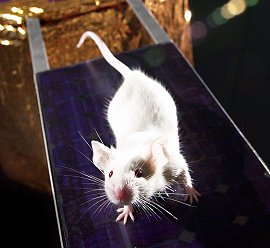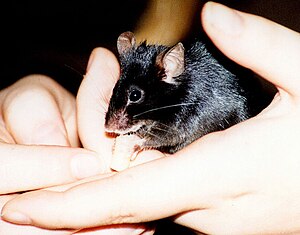AY Honors/Small Mammal Pets/Answer Key
Fancy mice ("fancy", in this context, means "hobby") are domesticated versions of the common or house mouse (Mus musculus).
Physical description
Fancy mice is a term to describe mice that have been selectively bred for pet or show. They can vary greatly in size, from small pet mice that are approximately 16-18 cm (6 inches or so) long from nose to the tip of the tail, to show mice that measure 30cm (12 inches) nose to tail. Pet mice weigh about 25-40 g but large show mice can weigh up to 100g. As fancy mice have a different process of natural selection than their wild cousins, they come in a variety of colours and patterns. These include black, chocolate, blue, white, cream, lilac, red, fawn, champagne, cinnamon, golden agouti, silver agouti, silver and dove. Female mice are called does and males are called bucks. If well cared for, a mouse lives for around 2 years on average, with some reaching 3 years old.
Mice as pets
Mice are kept as pets in many countries for a number of reasons. Fancy mice are small, inexpensive, clean, and generally have a good temperament. Female mice are popular with many owners since they tend to cohabitate with other mice better than males. Additionally, the urine of female fancy mice does not contain as strong of an odor as that of the male mice. Bucks can fight with each other, unless they are introduced at a very young age, and they produce urine with a strong, musky smell. Some people, however, prefer the personality and curiosity of male mice. It is a good idea to keep fancy mice in groups of at least two if possible, as mice are sociable animals. However, if a buck and a doe of breeding age are put in the same cage they will produce a new litter every three weeks until separated.
Caging
Mice should be kept in well-ventilated areas. Fish tanks or cages with bars and plastic flooring make good housing. Give attention that the distance between the bars is below than 9mm. Also at the doors. It is no problem for young mice to force themselves through a cage with wider bars, and it's dangerous when they get stuck there.
The best products for in-cage bedding are aspen wood shavings, dried corn cob, or a commercial paper-based material. Mice can also be given newspaper with black-and-white printing for nesting. But mice should not be given cedar shavings, as the oils in the wood are unhealthy. Small hide-aways and toys (such as a cardboard tube) are also good to have in the cage. Commercial toys are also available.
Cat owners must also take special precautions to ensure that the mouse's housing is secure, as even the friendliest of domestic cats have been known to torment or kill fancy mice if given the chance.
Feeding
Food for fancy mice is relatively inexpensive. Veterinarians generally recommend a product called lab block, a scientifically-formulated blend originally designed for mice in laboratories. Dry dog food is another good option when lab block is unavailable, as it offers balanced nutrition for a mouse and helps keep their teeth conditioned. Special mouse food found in pet stores also makes a good diet. In order to keep variety in their diets, mice can also eat oats, oily seeds, clean egg shell, breakfast cereal, and stale bread. Fruit and vegetables can be offered occasionally. They should also have clean water at all times and some sort of chewing wood in order to keep their teeth from growing too long.
Breeding mice
It is important to consider breeding carefully and to do so thoughtfully due to the very fast reproducton rate of mice, and the housing of the young.
Female mice should not be bred before 12 weeks or after 8 months. Doing so can be very dangerous and some mice can even die while giving birth. Don't forget, when a mouse gets to 9 months old they are already very old. Bucks and does should be housed in separate enclosures until you want to breed. When the time comes you can place them together. Place the doe in the buck's tank, otherwise the doe will fight with the buck to defend her territory. Does come into heat around every five days, so it is best to leave them together for ten days or so.
You can tell when a mouse is pregnant because they grow very round near to the time of birth. The gestation period goes 18 - 21 days. She will likely give birth to 8-12 though it can be more. It is best to remove the buck otherwise he will mate with the female as soon as the first litter is born, putting a huge strain on the mother, unborn litter and the new babies.
Baby mice (pups) are born blind, naked and deaf. Their eyes are closed and ears are stuck to the sides of their heads. It’s best to leave the mother alone for a while, otherwise she might panic and eat the babies. She might also eat any dead or sickly offspring, getting the litter down to a reasonable size. You can tell if the babies have drank any milk because their tummies turn white.
Hair begins to grow at two to four days; you can see what the patches in marked mice will look like now. Ears open at three to five days and they will start vocalizing more. Eyes open at 14 days and now the babies will start exploring the world around them. At 3 weeks old they look like miniature versions of adult mice. At 4-5 weeks pups must be separated otherwise they will breed with their siblings.
Mice as Feeder Animals
A very common use of mice currently is to feed many species of snakes, lizards, and even tarantulas. Most pet stores now carry mice for this purpose. They breed quickly, grow quickly, are easy to care for, and come in a wide variety of sizes due to this. This makes them suitable for consumption by many different size animals. Mice also seem to be a desirable food item for a very large variety of carnivores. Common terms used to refer to different age/size mice are pinkies, fuzzies, hoppers, and adults. Pinkies are newborn mice that have not yet grown fur. Fuzzies have some fur but are generally not very mobile, hoppers have a full coat of hair and are fully mobile but are smaller than adult mice. These terms also refer to the various growth stages of rats (also see Fancy rat).
Mice clubs
Many fancy mice clubs have been set up around the globe. Shows are also held so owners can display their mice. See External links below.



